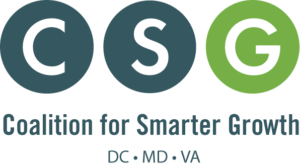A copy of the letter below was sent on Tuesday, February 13, 2020 to the WMATA Board of Directors.
Dear Chairman Smedberg, members of the WMATA Board, and GM Wiedefeld:
The Coalition for Smarter Growth is a 23-year-old non-profit and leading organization in the D.C. region advocating for walkable, inclusive, transit-oriented communities. We partner with dozens of DC area conservation, housing, transit and smart growth non-profit, advocacy organizations, and the business community, and are founding members of the MetroNow coalition which was instrumental in helping WMATA win the first-ever dedicated funding for the agency. We also served on the Executive Committee of the Bus Transformation Project. Today, MetroNow and our non-profit partners are committed to winning implementation of the recommendations of the BTP, including dedicated bus lanes and network redesign for faster, more frequent and reliable service, more affordable fares for lower income residents, technology improvements for off-board fare collection, and more.
We support a number of provisions in the draft budget but are concerned about others, particularly the proposed changes and cuts to bus service.
We support:
Restoration of late night service: Late night service is particularly important for service workers at late- night businesses, especially those who live in Virginia and Maryland. We support restoring late-night service, while still ensuring time for needed maintenance.
Free transfers between bus and rail: Free transfers were a top recommendation from the Bus Transformation Project and the second-most requested bus improvement after bus lanes in the survey. They were the top recommendation among low-income riders along with more affordable fares overall.
Low and lower pass costs: Lower pass costs are particularly helpful for lower-income riders and can support the transition to off-board fare collection which will speed buses.
Improved weekend service for bus and rail: This will support the access to jobs for all those who do not have traditional Monday to Friday work schedules, and support the transition to car free and car-light living for the tens of thousands of residents moving into transit-oriented communities in the city and suburbs.
We oppose:
Increasing the cash fare for Metrobus: This should only be done in conjunction with a much-improved Metro SmarTrip Retail Outlet program, establishment of an off-board fare payment option for Priority Corridor Network routes, and a new integrated payment and trip planning system.
Charging peak fares after midnight: This is inequitable for late-night workers.
A $1 surcharge for MetroExtra: We should be encouraging people to use limited-stop service, which saves operating funds, increased ridership, and helps people get to their destinations faster. We should not create a two-tier system that hurts lower-income riders by discouraging their use of faster buses.
Bus service changes and cuts: While some reconfigurations listed in the proposal may make sense, we have received significant negative feedback from our members about the proposed changes. To the extent that service cuts are being forced by the arbitrary 3% operating cost growth cap, we urge the Virginia and Maryland jurisdictions to remove the cap.
We prefer that WMATA and the region initiate a process for bus network redesign. This process can start with the proposed development of common service standards for WMATA and local bus services based on the frequency and coverage needs of our region. But any allocation or reallocation of service to WMATA or the local jurisdictions and major service changes like those being proposed, should take place after a network redesign study.
We also urge all area jurisdictions to continue to increase their operating funding necessary to expand bus service while making it faster, frequent and reliable. With climate change, we must maximize our investment in transit to support walkable, transit-oriented communities, access to jobs, and reduction in total vehicle miles traveled.
Thank you,
Stewart Schwartz Executive Director




 “In 2016, DC reformed its restrictions on accessory apartments, now we must ensure that homeowners, especially moderate and low income homeowners, can take full advantage of this new opportunity,” said Cheryl Cort, Coalition for Smarter Growth.
“In 2016, DC reformed its restrictions on accessory apartments, now we must ensure that homeowners, especially moderate and low income homeowners, can take full advantage of this new opportunity,” said Cheryl Cort, Coalition for Smarter Growth.
 About United Planning Organization
About United Planning Organization
